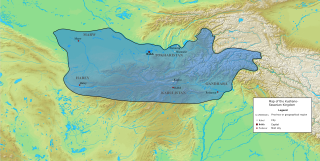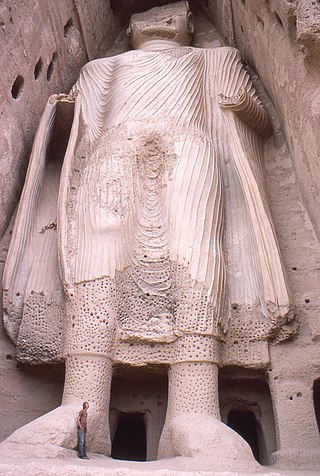
Kanishka I, Kanishka or Kanishka the Great, was an emperor of the Kushan dynasty, under whose reign the empire reached its zenith. He is famous for his military, political, and spiritual achievements. A descendant of Kujula Kadphises, founder of the Kushan empire, Kanishka came to rule an empire extending from Central Asia and Gandhara to Pataliputra on the Gangetic plain. The main capital of his empire was located at Puruṣapura (Peshawar) in Gandhara, with another major capital at Mathura. Coins of Kanishka were found in Tripuri.

Haḍḍa is a Greco-Buddhist archeological site located ten kilometers south of the city of Jalalabad, in the Nangarhar Province of eastern Afghanistan.
Zamindawar is a historical region of Afghanistan. It is a very large and fertile valley the main sources for irrigation is the Helmand River. Zamindawar is located in the greater territory of northern Helmand and encompasses the approximate area of modern-day Baghran, Musa Qala, Naw Zad, Kajaki and Sangin districts. It was a district of hills, and of wide, well populated, and fertile valleys watered by important tributaries of the Helmand. The principal town was Musa Qala, which stands on the banks of a river of the same name, about 60 km north of the city of Grishk.

Zabulistan, was a historical region in southern Afghanistan roughly corresponding to the modern provinces of Zabul and Ghazni. Following the Ghaznavid rule (977–1186), "Zabul" became largely synonymous with the name of its capital and main city, Ghazni.

Kushano-Sasanian Kingdom is a historiographic term used by modern scholars to refer to a branch of the Sasanian Persians who established their rule in Bactria during the 3rd and 4th centuries CE at the expense of the declining Kushans. They captured the provinces of Sogdiana, Bactria and Gandhara from the Kushans in 225 CE. The Sasanians established governors for the Sasanian Empire, who minted their own coinage and took the title of Kushanshas, i.e. "Kings of the Kushans". They are sometimes considered as forming a "sub-kingdom" inside the Sasanian Empire. This administration continued until 360-370 CE, when the Kushano-Sasanians lost much of its domains to the invading Kidarite Huns, whilst the rest was incorporated into the imperial Sasanian Empire. Later, the Kidarites were in turn displaced by the Hephthalites. The Sasanians were able to re-establish some authority after they destroyed the Hephthalites with the help of the Turks in 565, but their rule collapsed under Arab attacks in the mid 7th century.

Buddhism, an Indian religion founded by Gautama Buddha, first arrived in modern-day Afghanistan through the conquests of Ashoka, the third emperor of the Maurya Empire. Among the earliest notable sites of Buddhist influence in the country is a bilingual mountainside inscription in Greek and Aramaic that dates back to 260 BCE and was found on the rocky outcrop of Chil Zena near Kandahar.

Hinduism in Afghanistan is practiced by a tiny minority of Afghans, believed to be about 30-40 individuals as of 2021, who live mostly in the cities of Kabul and Jalalabad. Afghan Hindus are ethnically Pashtun, Hindkowan (Hindki), Punjabi, or Sindhi and primarily speak Pashto, Hindko, Punjabi, Sindhi, Dari, and Hindustani (Hindi-Urdu).

The Rabatak Inscription is a stone inscribed with text written in the Bactrian language and Greek script, found in 1993 at Rabatak, near Surkh Kotal in Afghanistan. The inscription relates to the rule of the Kushan emperor Kanishka, and gives remarkable clues on the genealogy of the Kushan dynasty. It dates to the 2nd century CE.

Communities of various religious and ethnic background have lived in the land of what is now Afghanistan. Before the Islamic conquest, south of the Hindu Kush was ruled by the Zunbil and Kabul Shahi rulers. When the Chinese travellers visited Afghanistan between 399 and 751 AD, they mentioned that Hinduism and Buddhism was practiced in different areas between the Amu Darya in the north and the Indus River in the south. The land was ruled by the Kushans followed by the Hephthalites during these visits. It is reported that the Hephthalites were fervent followers of the Hindu god Surya.
Abu Ali Lawik of the Lawik dynasty was the son of Abu Bakr Lawik, and also a brother-in-law of the Hindu Shahi ruler of the region, Kabul Shah. He was invited by the people of Ghazni to overthrow Böritigin or Pirai and proceeded in alliance with the Shahi Rulers of the region in this venture.
'Yamini Turks had claimed their descent from Shahyar, the last of the Parthian ruler who was killed in 637AD in the battle of Cadesia. The family had migrated to Turkistan and after three generations had passed on as Turks. Their founder Sabuktgin had come into the service of Alptgin, a Samanid governor of Turkistan. The latter had captured Ghazni and settled there in 963AD. He raised Sabuktigin to the position of a general. After the death of Alptgin in 966 AD, Balktgin the commander of Turkish troops succeeded him who was later succeeded by Pirai a slave. The latter was a cruel king and the people of Zabul invited Abu Ali Lawik son of the last ruler of Zabul who in alliance with the Shahis of Udabhanda marched to recover Ghazni. On the way at Charkh, Sabuktgin defeated them and became a hero.
Zunbil, also written as Zhunbil, or Rutbils of Zabulistan, was a royal dynasty south of the Hindu Kush in present southern Afghanistan region. They ruled from circa 680 AD until the Saffarid conquest in 870 AD. The Zunbil dynasty was founded by Rutbil, the elder brother of the Turk Shahi ruler, who ruled over Hephthalite kingdom from his capital in Kabul. The Zunbils are described as having Turkish troops in their service by Arabic sources like Tarikh al-Tabari and Tarikh-i Sistan.

The Hindu Shahis were a dynasty that held sway over the Kabulistan, Gandhara and western Punjab during the early medieval period in the Indian subcontinent. Details regarding past rulers can only be assembled from disparate chronicles, coins and stone inscriptions.
The Nezak Huns, also Nezak Shahs, was a significant principality in the south of the Hindu Kush region of South Asia from circa 484 to 665 CE. Despite being traditionally identified as the last of the Hunnic states, their ethnicity remains disputed and speculative. The dynasty is primarily evidenced by coinage inscribing a characteristic water-buffalo-head crown and an eponymous legend.
The Turk Shahis or Kabul Shahis were a dynasty of Western Turk, or mixed Turko-Hephthalite, origin, that ruled from Kabul and Kapisa to Gandhara in the 7th to 9th centuries AD. They may have been of Khalaj ethnicity. The Gandhara territory may have been bordering the Kashmir kingdom and the Kanauj kingdom to the east. From the 560s, the Western Turks had gradually expanded southeasterward from Transoxonia, and occupied Bactria and the Hindu-Kush region, forming largely independent polities. The Turk Shahis may have been a political extension of the neighbouring Western Turk Yabghus of Tokharistan. In the Hindu-Kush region, they replaced the Nezak Huns – the last dynasty of Bactrian rulers with origins among the Xwn (Xionite) and/or Huna peoples.

The Tokhara Yabghus or Yabghus of Tokharistan were a dynasty of Western Turk–Hephtalite sub-kings with the title "Yabghus", who ruled from 625 CE in the area of Tokharistan north and south of the Oxus River, with some smaller remnants surviving in the area of Badakhshan until 758 CE. Their legacy extended to the southeast where it came into contact with the Turk Shahis and the Zunbils until the 9th century CE.

The Fondukistan monastery was a Buddhist monastery located at the very top of a conical hill next to the Ghorband Valley, Parwan Province, about 117 kilometers northeast of Kabul. The monastery dates to the early 8th century CE, with a terminus post quem in 689 CE obtained through numismatic evidence, so that the Buddhist art of the site has been estimated to around 700 CE. This is the only secure date for this artistic period in the Hindu Kush, and it serves as an important chronological reference point.

Tepe Sardar, also Tapa Sardar or Tepe-e-Sardar, is an ancient Buddhist monastery in Afghanistan. It is located near Ghazni, and it dominates the Dasht-i Manara plain. The site displays two major artistic phases, an Hellenistic phase during the 3rd to 6th century CE, followed by a Sinicized-Indian phase during the 7th to 9th century.

The Seal of Khingila is an historical seal from the region of Bactria, on southern Central Asia. The seal was published recently by Pierfrancesco Callieri and Nicholas Sims-Williams. It is now in the private collection of Mr. A. Saeedi (London). Kurbanov considers it as a significant Hephthalite seal. It has also been considered as intermediate between the Kidarites and the Hephthalites.

Barha Tegin was the first ruler of the Turk Shahis. He is only known in name from the accounts of the Muslim historian Al-Biruni and reconstructions from Chinese sources, and the identification of his coinage remains conjectural.

Khingala, also transliterated Khinkhil, Khinjil or Khinjal, was a ruler of the Turk Shahis. He is only known in name from the accounts of the Muslim historian Ya'qubi and from an epigraphical source, the Gardez Ganesha. The identification of his coinage remains conjectural.


















